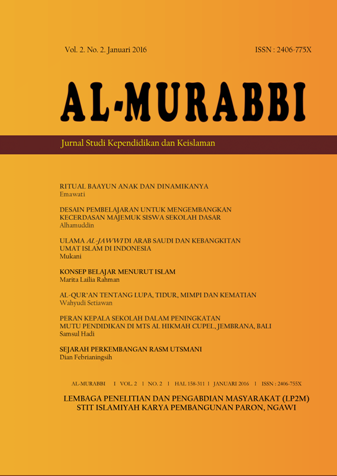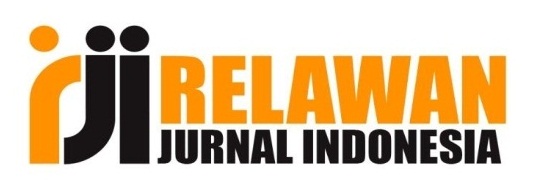DESAIN PEMBELAJARAN UNTUK MENGEMBANGKAN KECERDASAN MAJEMUK SISWA SEKOLAH DASAR
Abstract
This study aims to examine how to instruction design to optimize the potential of learners. The result of study showed that the design instruction to optimize the learners needs to do several steps, namely: (1) multiple intelligences research; (2) mapping class based on learning style. Furthermore, teachers prepare learning design based on both aspects. Teacher consultation with the supervisor in preparing instructional design based on multiple intelligences, in consultation teacher discusses basic competencies to be taught and strategies in accordance with the tendency of learners in the classroom. The next phase is the observation supervisor in the classroom and the last step is the confirmation. Based on the results of this study, the researchers recommend to teachers to always pay attention and develop the potential that exists within the self-learners early on. Intelligence is not just limited to the intelligence of mathematical logic and language, but also kinesthetic, music, interpersonal, intrapersonal, spatial, and naturalistic intelligence.
Keywords: Design, Instructional, Multiple Intelligences
Downloads
References
Baum, Susan., Viens, Julie., & Slatin, Barbara. (2005). Multiple Intelligences in the Elementary Classroom. New York. Teacher College, Columbia University.
Budiningsih, Asri C. (2005). Belajar dan Pembelajaran. Jakarta. Rineka Cipta.
Campbell, L., Campbell, B., & Dickinson, D. (1996). Teaching and Learning through Multiple Intelligences. Needham Heights,MA. Allyn & Bacon.
Fleetham, Mike. (2006). Multiple Intelligences in Practice Enhancing Self-Esteem and Learning in the Classroom. Stafford. Network Continum Education.
Gardner, Howard. (1993a). Frames of Mind; The Theory of Multiple Intelligences-10th anniversary edition. New York. Basic Books.
_______________(1993b). Multiple Intelligences. The Theory in Practice. New York. Basic Books.
Hoerr, Thomas R. (2000). Becoming a Multiple Intelligences School. Virginia. ASCD.
Huberman, A.M. dan Miles, M. B. (1985). Qualitative Data Analysis; a Sourcebook of New Methods. London. Sage Publications.
Jasmine, Julia. (2012). Profesional’s Guide Teaching with Multiple Intelligences (Metode Mengajar Multiple Intelligences)(Terj). Bandung. Nuansa Cendekia.
Lazear, David G. (1992). Teaching for Multiple Intelligences. Indiana. Phi Delta Kappa Education Foundation.
McKenzie, Walter. (2005). Multiple Intelligences and Instructional Technology. Washington. International Society for Technology in Education.
Moleong. (2002). Metodologi Penelitian Kualitatif. Bandung. Remaja Rosdakarya
Muhaimin. (2003). Arah Baru Pengembangan Pendidikan Islam. Pemberdayaan, Pengembangan Kurikulum hingga Redefinisasi Islamisasi Pengetahuan. Bandung. Nuansa Cendekia.
Pasak, Taufik. (2007). Brain Management for Self Improvement. Bandung. Mizan.
Rasydianah, Andi. (1995). Butir-Butir Pengarahan Dirjen Bimbaga Islam pada Acara Pelatihan Peningkatan Wawasan Ilmu Pengetahuan dan Kependidikan Bagi Dosen Pendidikan Agama Islam pada Perguruan Tinggi Umum. Bandung, 11 September 1995.
Rose, C dan Nichol, M.J. (2001). Accelerated Learning for the 21st century (Cara Belajar Cepat Abad XXI). Penerjemahah; Dedi Ahimsa. Bandung. Nuansa Kerjasama dengan Pusat Perbukuan Depdiknas.
Salim, Agus. (2006). Teori & Paradigma Penelitian Sosial. Buku Sumber untuk Penelitian Kualitatif. Yogyakarta. Tiara Wacana.
Semiawan, Conny. (1999). Pendidikan Tinggi, Peningkatan Kemampuan Manusia Sepanjang Hayat Seoptimal Mungkin. Jakarta. Depdikbud. Dirjen Dikti
Suparno, Paul. (1997). Filsafat Konstruktivisme dalam Pendidikan. Yogyakarta. Kanisius.
Syukri. (2003). Pendidikan Islam dalam Konteks Politik Pendidikan Nasional. Jurnal Ulumuna. 7 (12).
Tomlinson, Carol Ann. (1999). The Differentiated Classroom. Responding to the Needs of All Learners. Virginia. Ascd.
Yaumi, Muhammad. (2012). Pembelajaran Berbasis Multiple Intelligences. Jakarta. Dian Rakyat.
Yin, Robert K..(1994). Case Study Research; Design and Methods. Newbury Park CA. Sage Publication.
Copyright (c) 2016 AL-MURABBI

This work is licensed under a Creative Commons Attribution-ShareAlike 4.0 International License.











